#shinohara ryu
Explore tagged Tumblr posts
Text




Karaoke Terror | 昭和歌謡大全集 (2003) dir. Shinohara Tetsuo
#movie stills#cinematography#film stills#japanese cinema#2000s#comedy#drama#satire#based on novel#ryu murakami#昭和歌謡大全集#karaoke terror#the complete showa songbook#popular hits of the showa era#maybe i should read the book huh#i like murakami anyway#shinohara tetsuo#expected more karaoke / singing#ryuhei matsuda#kishimoto kayoko#ichikawa miwako#im seeing a pattern with murakami btw lol
11 notes
·
View notes
Text

Special Guest appearance:
Shinichi Shinohara
4 notes
·
View notes
Text
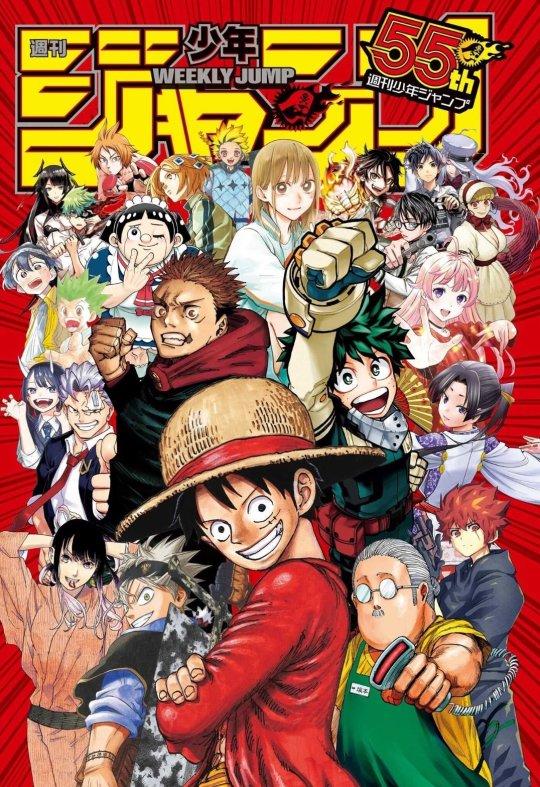
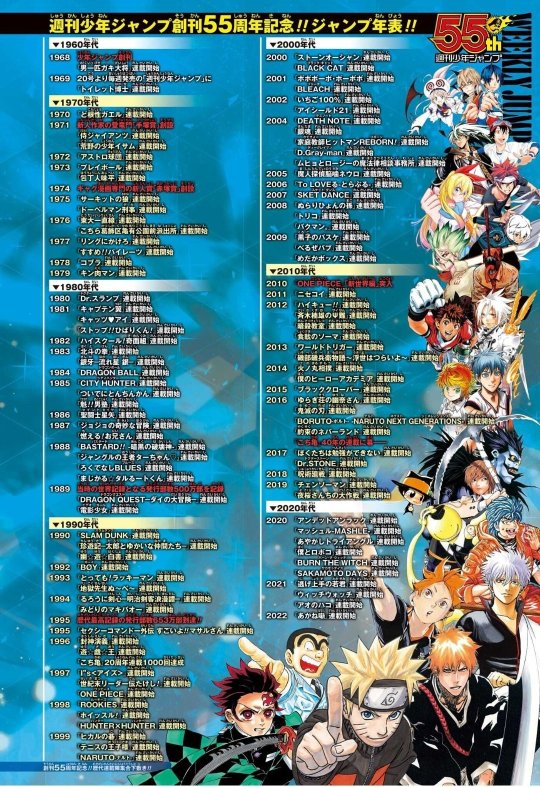
Weekly Shonen Jump 55th anniversary appendix in Weekly Shonen Jump 2023 issue #33
1968 Weekly Shonen Jump Issue #1 Otoko Ippiki Gaki-Daisho by Hiroshi Motomiya 1969 Dr. Toilet by Kazuyoshi Torii 1970 The Gutsy Frog by Yasumi Yoshizawa 1971 Tezuka Manga Award 1st Edition Samurai Giants by Ikki Kajiwara & Ko Inoue Boy of the Wilderness Isamu by Soji Yamakawa & Noboru Kawasaki 1972 Astro Kyudan by Shiro Tōzaki & Norihiro Nakajima 1973 Play Ball by Akio Chiba Hochonin Ajihei by Jiro Gyu & Jo Big 1974 Akatsuka Manga Award 1st Edition 1975 The Circuit Wolf by Satoshi Ikezawa Doberman Deka by Buronson & Shinji Hiramatsu 1976 Toudai Icchokusen by Yoshinori Kobayashi Kochikame by Osamu Akimoto 1977 Ring ni Kakero by Masami Kurumada Susume!! Pirates by Hisashi Eguchi 1978 Cobra by Buichi Terasawa 1979 Kinnikuman by Yudetamago 1980 Dr. Slump by Akira Toriyama 1981 Captain Tsubasa by Yoichi Takahashi Cat's Eye by Tsukasa Hojo Stop!! Hibari-kun! by Hisashi Eguchi 1982 High School! Kimengumi by Motoei Shinzawa 1983 Fist of the North Star by Buronson & Tetsuo Hara Ginga -Nagareboshi Gin- by Yoshihiro Takahashi 1984 DRAGON BALL by Akira Toriyama 1985 City Hunter by Tsukasa Hojo Miraculous Tonchinkan by Koichi Endo Sakigake!! Otokojuku by Akira Miyashita 1986 Saint Seiya by Masami Kurumada 1987 JoJo's Bizarre Adventure by Hirohiko Araki The Burning Wild Man by Tadashi Sato 1988 Bastard!! by Kazushi Hagiwara Jungle King Tar-chan by Masaya Tokuhiro Rokudenashi BLUES by Masanori Morita Magical Taluluto by Tatsuya Egawa 1989 Weekly Shonen Jump reaches 5.000.000 copies in circulation Dragon Quest: The Great Adventure of Dai by Riku Sanjo & Koji Inada Video Girl Ai by Masakazu Katsura 1990 SLAM DUNK by Takehiko Inoue Chinyuki by Man Gataro Yu Yu Hakusho by Yoshihiro Togashi 1992 Hareluya II Boy by Haruto Umezawa 1993 Tottemo! Luckyman by Hiroshi Gamo Hell Teacher Nube by Makura Sho & Takeshi Okano 1994 Midori no Makibao by Tsunomaru Rurouni Kenshin by Nobuhiro Watsuki 1995 Weekly Shonen Jump reaches 6.530.000 copies in circulation Sexy Commando Gaiden: Sugoi yo!! Masaru-san by Kyosuke Usuta 1996 Hoshin Engi by Ryu Fujisaki Yu-Gi-Oh! by Kazuki Takahashi Kochikame 20th Anniversary & Chapter 1000 1997 I's by Masakazu Katsura Seikimatsu Leader den Takeshi! by Mitsutoshi Shimabukuro ONE PIECE by Eiichiro Oda 1998 Rookies by Masanori Morita Whistle! by Daisuke Higuchi HUNTERXHUNTER by Yoshihiro Togashi 1999 Hikaru no Go by Yumi Hotta & Takeshi Obata The Prince of Tennis by Takeshi Konomi NARUTO by Masashi Kishimoto 2000 JoJo's Bizarre Adventure: Stone Ocean by Hirohiko Araki BLACK CAT by Kentaro Yabuki 2001 Bobobobo Bobobo by Yoshio Sawai BLEACH by Tite Kubo 2002 Strawberry 100% by Mizuki Kawashita Eyeshield 21 by Riichiro Inagaki & Yusuke Murata 2004 Death Note by Tsugumi Ohba & Takeshi Obata Gintama by Hideaki Sorachi Katekyo Hitman Reborn! by Akira Amano D.Gray-man by Katsura Hoshino Muhyo & Roji's Bureau of Supernatural Investigation by Yoshiyuki Nishi 2005 Neuro: Supernatural Detective by Yusei Matsui 2006 To Love Ru by Saki Hasemi & Kentaro Yabuki 2007 Sket Dance by Kenta Shinohara 2008 Nura: Rise of the Yokai Clan by Hiroshi Shiibashi Toriko by Mitsutoshi Shimabukuro Bakuman. by Tsugumi Ohba & Takeshi Obata 2009 Kuroko's Basketball by Tadatoshi Fujimaki Beelzebub by Ryuhei Tamura Medaka Box by Nisio Isin & Akira Akatsuki 2010 ONE PIECE New World Begins 2011 Nisekoi by Naoshi Komi 2012 Haikyu!! by Haruichi Furudate The Disastrous Life of Saiki K. by Shuichi Aso Assassination Classroom by Yusei Matsui Food Wars: Shokugeki no Soma by Yuto Tsukuda & Shun Saeki 2013 World Trigger by Daisuke Ashihara Isobe Isobee Monogatari by Ryo Nakama 2014 Hinomaru Zumo by Kawada My Hero Academia by Kohei Horikoshi 2015 Black Clover by Yuki Tabata 2016 Yuuna and the Haunted Hot Springs by Tadahiro Miura Kimetsu no Yaiba by Koyoharu Gotouge BORUTO by Mikio Ikemoto & Ukyo Kodachi The Promised Neverland by Kaiu Shirai & Posuka Demizu Kochikame 40th Anniversary and Serialization End 2017 We Never Learn by Taishi Tsutsui Dr. STONE by Riichiro Inagaki & Boichi 2018 Jujutsu Kaisen by Akutami Gege
2019 Chainsaw Man by Tatsuki Fujimoto Mission: Yozakura Family by Hitsuji Gondaira 2020 Undead Unluck by Yoshifumi Tozuka MASHLE by Hajime Komoto Ayakashi Triangle by Kentaro Yabuki Me & Roboco by Shuhei Miyazaki BURN THE WITCH by Tite Kubo SAKAMOTO DAYS by Yuto Suzuki 2021 The Elusive Samurai by Yusei Matsui WITCH WATCH by Kenta Shinohara Blue Box by Kouji Miura 2022 Akane Banashi by Yuki Suenaga & Takamasa Moue
#Weekly Shone Jump#One Piece#Dragon Ball#Naruto#Slam Dunk#KochiKame#Demon Slayer#Bleach#JoJo's Bizarre Adventure#Fist of the North Star#My Hero Academia#Hunter x Hunter#Jujutsu Kaisen#Yu Yu Hakusho#Kinnikuman#Rurouni Kenshin#The Prince of Tennis#Rokudenashi Blues#Gintama#Haikyu!!#manga#long post#late post
219 notes
·
View notes
Text
⚡ JUMP FESTA 2025: TUTTI I TRAILER E GLI ANNUNCI ARRIVATI DURANTE IL GRANDE EVENTO!
Fra tante novità attese e date un po' fumose, spunta la serie di My Hero Academia Illegals, in arrivo già da aprile!

Quest'anno sono riuscito a mettere tutto dentro un solo post! Miracolo di Natale!
Due giorni di Jump Festa un po' meno ricchi degli anni precedenti, ma c'è comunque di cui parlare, anche se in breve. Vi lascio al mega recap e buone feste!
🔶🔸CHAINSAW MAN THE MOVIE: REZE ARC

Per questo film MAPPA (Jujutsu Kaisen, Hell’s Paradise) cambia regista, mettendo al timone Tatsuya Yoshihara (Black Clover, Wistoria: Wand and Sword), con al fianco Masato Nakazono (Oblivion Battery) in qualità di assistente.
I due prendono quindi in mano il sequel cinematografico al posto di Ryu Nakayama, che da quanto vedo è tornato ad occuparsi di progetti minori, come videoclip musicali.
La pellicola adatta l'omonimo arco narrativo del manga ed è, tuttora, prevista per un generico 2025.
youtube
🔶🔸TAKOPI’S ORIGINAL SIN

Come promesso, è stato svelato qualche dettaglio in più assieme ad un primo teaser dell'anime, tratto dal breve sci-fi slice of life drama di Taizan 5.
La trasposizione del manga è attesa per il 2025 ed è scritta e diretta da Shinya Iino (Dr. Stone), presso ENISHIYA.
Questo è il primo progetto grosso dello studio, ma da quello che si vede nel video, sembrano aver fatto un gran bel lavoro!
youtube
🔶🔸 WITCH WATCH

Arrivato anche un nuovo trailer per la fantasy romcom basata sull'ultima fatica di Kenta Shinohara (Astra Lost in Space, SKET Dance).
Il debutto della serie made in BIBURY ANIMATION STUDIOS (The 100 Girlfriends Who Really, Really, Really, Really, Really Love You) è fissato per aprile 2025.
Come regista troviamo Hiroshi Ikehata (Tonikawa: Over The Moon For You), con Masao Kawase (Magical Destroyers) nel ruolo di assistente di regia.
youtube
🔶🔸VIGILANTE - MY HERO ACADEMIA ILLEGALS

Annunciata per aprile 2025 la serie animata dello spinoff di My Hero Academia, scritto da Hideyuki Furuhashi e illustrato da Bettencourt!
Il progetto rimane in casa BONES (Bungo Stray Dogs, Mob Psycho 100), anche se si sposta all'interno delle mura del nuovo studio parente BONES FILM. Il regista, invece, è Kenichi Suzuki (Cells at Work!, Drifters).
youtube
Sempre a proposito di MY HERO ACADEMIA, l’ottava e ultima stagione della serie principale, annunciata l'ottobre scorso, ha un periodo di debutto ufficiale ora: la parte finale della saga verrà trasmessa a partire dall'autunno 2025.

🔶🔸SAKAMOTO DAYS

Nuovo trailer in attesa del debutto su Netflix dell’action family comedy, basata sul popolare manga di Yuto Suzuki.
Sapevamo già che verrà doppiata in italiano e che il simulcast partirà l’11 gennaio, ma durante l'evento è stato svelato un altro dettaglio: la stagione sarà divisa in due parti e la seconda andrà in onda durante l'estate 2025.
L'anime è diretto da Masaki Watanabe (KADO - The Right Answer, Battle Spirits) ed è una produzione targata TMS ENTERTAINMENT (Dr. Stone, Rent-a-Girlfriend).
youtube
🔶🔸RAMEN AKANEKO

Annunciata la produzione di una seconda stagione per la simpatica commedia slice of life, tratta dal manga firmato Angyaman, che qua in Italia conosciamo anche con il titolo Red Cat Ramen, grazie all'edizione a cura di Dynit Manga.
I primi 12 episodi della serie sono stati distribuiti da Yamato Video, sul canale ANiME GENERATION di Prime Video.
🔶🔸DAN DA DAN

Giusto dopo l'annuncio di qualche giorno fa, un po' di punto in bianco fra l'altro a livello narrativo, non poteva proprio mancare il teaserino per la seconda stagione non appena confermata. Se l'erano tenuto per l'evento, ovviamente.
Come vi ho già anticipato nel post originale, la paranormal mystery battle & romantic comedy, tratta dal manga di Yukinobu Tatsu, tornerà a partire da luglio 2025.
youtube
🔶🔸KAIJU No. 8

Parlando sempre di seconde stagioni in cantiere, assieme ad una nuova immagine promozionale, è stato finalmente svelato che la serie tornerà da luglio 2025.
Durante il panel, è stato anche mostrato un trailer per il film che andrà a riassumere la prima stagione, che vi linko qua.
Questa compilation includerà anche un originale episodio speciale dal titolo “Il giorno libero di Hoshina” e uscirà in Giappone il 28 marzo 2025.
È stato anche detto che verrà distribuita globalmente e questo mi fa pensare che Crunchyroll ce la porterà al cinema.
🔶🔸HELL’S PARADISE

Rimaniamo sulle seconde stagioni molto attese, grande enfasi su "attese" in questo caso particolare.
È passato più di un anno da quando è stato confermato il sequel, ma l'annuncio di quando la serie proseguirà con i nuovi episodi è arrivato, finalmente. Non avete fretta, vero? Perché, salvo contrattempi, fino a gennaio 2026 non se ne fa nulla. (Ora riguardate la key visual e ditemi se non è anche la vostra espressione quella)
Se vi può consolare, Crunchyroll ha già anticipato che la riporterà in simulcast però. 😂
youtube
Ricordate l'episodio speciale di UNDEAD UNLUCK, previsto per l’inverno 2025? Ecco, lo staff ha tenuto a precisare, come se non fosse abbastanza scontato, che animerà una storia inedita, scritta per l'occasione dall'autore stesso del manga.
Di seguito trovate lo sketch del nuovo UMA chiamato Balance, che comparirà nello special.

MISSION: YOZAKURA FAMILY

Torno un attimo a parlarvi di serie ancora in lontananza, ma rimanendo in casa Disney+.
La seconda stagione dell’action family comedy, tratta dal manga di Hitsuji Gondaira, è ancora in alto mare. La finestra di debutto, infatti, rimane su un generico 2026.
🔶🔸3-NEN Z-GUMI GINPACHI-SENSEI

Ci riavviciniamo un pochino, con il nuovo promo per lo spinoff scolastico di Gintama, che è invece ora programmato ufficialmente per essere trasmesso a partire da ottobre 2025.
youtube
E con questa bella illustrazione celebrativa, vi informo che pure la terza stagione di SPY × FAMILY andrà in onda da ottobre 2025!

Ho quasi finito, lo giuro! Che di AHAREN-SAN WA HAKARENAI stava arrivando la seconda stagione lo sapevamo già, ma ora vi posso dire anche quando: la spensierata romcom, tratta dal manga di Asato Mizu, tornerà su Crunchyroll da aprile 2025!
youtube
Il ritaglietto finale lo dedico a JUJUTSU KAISEN, visto che all'orizzonte c'è più che mai un bel riassuntone della seconda stagione, in uscita nei cinema nipponici il 30 maggio 2025.
Come per Hell's Paradise, il sequel che andrà ad adattare la saga del Girone Mietitore è stato confermato ormai più di un anno fa, ma non ha ancora uno straccio di finestra d'uscita. D'altronde è sempre MAPPA.
Nel frattempo ci lasciamo con la prima "super teaser visual" in rosso, che vedete qui sotto sulla destra.

Oh, giusto: la saga di ONE PIECE ripartirà con i nuovi episodi dal 6 aprile 2025.
youtube
⫸ NON VUOI PERDERTI NEANCHE UN POST? ENTRA NEL CANALE TELEGRAM! ⫷

Autore: SilenziO))) Se usate Twitter, mi trovate lì!
blogger // anime enthusiast // twitch addict // unorthodox blackster - synthwave lover // penniless gamer // INFJ-T magus
#jump festa#jump festa 2025#fiere#anime#chainsaw man#my hero academia#takopii no genzai#witch watch#my hero academia illegals#vigilante#sakamoto days#ramen akaneko#kaiju no. 8#dandadan#hell's paradise#jigokuraku#mission yozakura family#spy x family#gintama#ginpachi sensei#aharen san wa hakarenai#jujutsu kaisen#one piece#undead unluck
6 notes
·
View notes
Photo
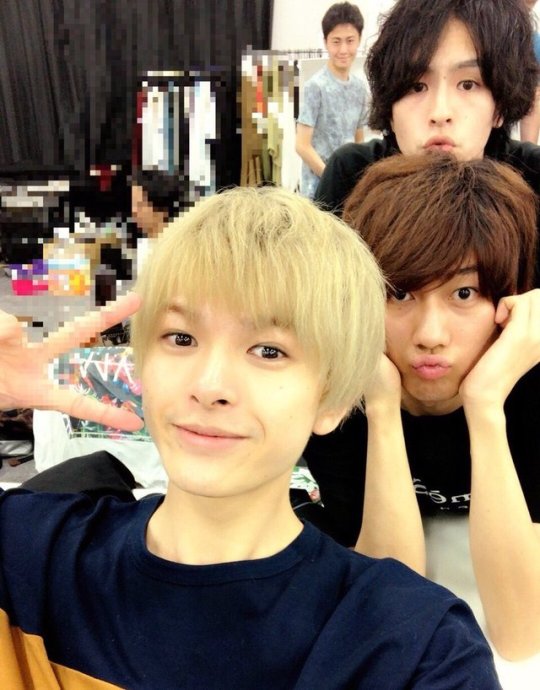



16 July 2018
Going to Brave10 rehearsals!
It’s! So! Hot! (x, x, x)
#kosaka ryoutarou#source: twitter#stage: brave10#asuma kousuke#wago shinichi#matsuda kazuki#imari yu#hayama subaru#miyagi koudai#shinohara ryu#ito yui#washio shuuto#sueno takuma
17 notes
·
View notes
Photo




Super Sentai Monsters
153 notes
·
View notes
Photo




Twitter update [2017/06/14] - In full Hattori Hanzo costume for today (they had a video shooting for some of the casts). And photos of Hanzo!Kousuke with Benmaru, Anastasia and Isanami. *edited
#the mask is giving me life#asuma kousuke#kousuke asuma#hattori hanzo#brave 10#isobe karin#mamoru asana#shinohara ryu#my post
89 notes
·
View notes
Photo

1 note
·
View note
Text
Actor of the Day: Shinohara Ryu
Sporting an absolutely adorable bowl cut for the role of Kato Kachiro, today’s Actor of the Day is Shinohara Ryu. He was born on February 5th, 1996 and at the age of twenty he became the first Kato Kachiro of the Seigaku 8th generation alongside the other first Seigaku actors of the third season of TeniMyu. He replaced Mitsui Ryo from the Seigaku 7th generation and performed in Seigaku vs Fudomine, Team Live SEIGAKU, and Seigaku vs. St. Rudolph before graduating from the role on September 27th, 2016. While he was with the cast, he captivated the audience with his adorable appearance, endless energy, and his endearing personality. Outside of the performance world he runs a blog that is sponsored by the talent agency he is signed with, J-Beans. While he says that the blog is difficult to keep up with during performances, he’s always happy to make updates that thank his fans and cast mates for all of their support during the shows. He also has fun posting photos from the cities they perform in and photos that he takes back stage with the rest of the cast. While Ryu doesn’t have much else under his belt other than the TeniMyu performances, we are excited to see where his budding career takes him.
Read more!
2 notes
·
View notes
Photo

Characters more interesting than Yumi Sawamura: Shinohara Shinichi
#characters more interesting than yumi sawamura#yakuza#yakuza kiwami#ryu ga gotoku#rgg#like a dragon#shinohara shinichi#sega#video games
29 notes
·
View notes
Text
🔑 WHERE TO FIND KEY 🔑
bnha :
@iracxndiaa - dabi / touya todoroki
@iinfernum - endeavor / enji todoroki
obey me ! :
@cupiiiditas - asmodeus
multi-fandom :
@ikuinxn - multi-fandom, multi-muse
chitose kizuki ( canon div. )
koku hanabata ( canon div. )
shouta aizawa ( canon div. )
kai chisaki ( canon div. )
eito chisaki ( canon div. )
ogami shigaraki ( oc )
ita akagi ( oc )
shigeko kizuki ( oc )
yuri katsuki ( canon div. )
hisoka morow ( canon div. )
sei ( canon div. )
hades ( canon div. )
persephone ( canon div. )
widowmaker ( canon div. )
ueda akinari ( bnha au oc )
yosano akiko ( bnha au oc )
ryu murakami ( bnha au oc )
yusuke kishi ( bnha au oc )
@nxctiis - oc multi-muse
akagarii aoki ( oc )
nishioka aki ( oc )
shinohara koji ( oc )
sugita tatsuo ( oc )
sama tadashi ( oc )
ishii kiku ( oc )
taiichi aoki ( oc )
shinya aoki ( oc )
jjba :
@dixbolxs - jjba multi-muse
giorno giovanna ( canon div. )
styx ( oc )
cioccolata ( canon div. )
killer queen ( canon div. )
bsd:
@mxdicxte - yosano akiko ( canon div. )
@malxfica - ueda akinari ( oc )
@deorxm - multi-muse
h.p lovecraft ( canon div. )
francis scott key fitzgerald ( canon div. )
bram stoker ( oc )
stephen “church” king
oscar wilde ( oc )
ryunosuke akutagawa ( canon div. )
chitose kizuki ( bsd au oc )
fyodor dostoevsky ( canon div. )
beast beneath the moonlight / byakko ( canon div. )
ryu murakami ( oc )
koku hanabata ( bsd au oc )
yusuke kishi ( oc )
#◤ i'll burn your name into my throat i'll be the fire that'll catch you || out of character ◢#// where to find me#// this doesn't include my personal but yeah
4 notes
·
View notes
Text
Takeda Kanryuusai [shinsengumi-no-makoto]
Captain of the Fifth Unit
Born - Unknown. From the Izumo province, in western Honshu.
Died - Uncertain. Either September 28, 1866 or June 22, 1867 in Kyoto.
[Either November 5, 1866 or July 23, 1867.]
Names -
Imina - Tokuhiro
No information is currently available on his original family name. He was adopted by the Takeda family while he was studying in Edo [Tokyo].
Personality Quirks and Traits -
Takeda is said to have got along well with Kondo, but was generally disliked by the rest of the group. Rumor has it that he had a tendency to ingratiate himself with those in power while abusing his authority over others. A famous example of this is the story that he harassed a “cute” member of the group named Magoshi Saburo. This incident is also supposed to show that he was known for “danshoku” (male homosexuality) as well. However there seems to be no real proof of either accusation.
In his defense, it can be said that Takeda was an intelligent person. He also attempted to help Kondo by trying to smooth things over during the incident where Nagakura and others filed a petition against the Commander. Against him, it can be said that he attempted to abandon the Shinsengumi when he realized that they were going to be on the losing side.
Before the Shinsengumi -
At one point early on, Takeda may have studied medicine.
He was known to have studied the doctrines of Wang Yang-ming, called Oyomei thought. This led to him having some rather outspoken views against the shogunate. It got him arrested, but Takeda broke out of prison and fled from the Izumo province to Edo. He continued his studies there for a while.
Martial Skills -
Takeda does not appear to have been known for his skill with a sword. He was however a master of the Naganuma Ryu of military strategy.
Shinsengumi Years -
Takeda joined the group in October of 1863 and was originally the group’s military advisor. Eventually he was pushed out of this position by Ito Kashitaro, who knew western military arts. At this time he became Captain of the Fifth Unit and was a Teacher of Literature and Culture. He remained in this position until his death.
Takeda seems to have wanted to join with Ito’s group, but was turned away. Later he made the decision to leave the Shinsengumi alone and join the Satsuma clan. He tried to cover himself by getting permission to “go home”. Unfortunately for him, Kondo and Hijikata were already aware of his true intentions. On the surface they agreed with his request and threw him a farewell party. In truth they were setting him up to be assassinated.
At this point it becomes unclear who actually carried out the order and when. There are two dates given for this event. One is September 28, 1866 [November 5, 1866] and the other is June 22, 1867 [July 23, 1867]. If it was carried out by the usual suspect, Saito Hajime, then the September 28th date makes far more sense. At that time Saito had not departed the Shinsengumi with Ito and his followers and Kondo would have been able to freely give him such orders.
The issue becomes more confusing if the June 22nd date is correct. At this time Saito had left the Shinsengumi, possibly to spy on Ito for Kondo and Hijikata. The two groups were pretending to maintain friendly relations with each other and so members from either side were able to attend the social functions of the other. It is thought that at some point during the party Saito was given the secret order to kill Takeda.
The main problem with this later date is that Saito is suspected because Shinohara Tainoshin supposedly witnessed the murder. It seems unlikely that Ito would have trusted Saito after that unless the killing took place before they ever left the Shinsengumi. If it indeed happened afterwards and Saito is the culprit, then there are only a few reasonable explanations as to why Ito did not put himself on guard after this incident. One may be the fact that he himself was in contact with the Satsuma clan. If he feared that Takeda’s dealings with them might somehow jeopardize his own, then perhaps he might have been the one to tip off the Shinsengumi and so was in on the assassination. Another is that perhaps Saito was able to convince Shinohara that the murder was something personal between him and Takeda. Or perhaps his reasons for killing the other captain really were personal and not anything connected with the Shinsengumi.
Another theory is that the later date is correct, but that Saito was in fact not involved with the murder at all. In this scenario other members of the group carried out the assassination.
Takeda’s murder occurred at the Zenitori bridge on the Taketa highway. Most versions of the story have it that Saito and Shinohara were “seeing him off” and walked with him to this location after the party was over. Takeda was probably drunk at that point. Saito came up behind him and struck him down, then scoffed at the other man’s “high sounding words”.
Of course that depends on whether or not Saito was indeed the killer. Most likely Takeda’s death will always remain something of a mystery.
The Doctrines of Wang Yang-ming -
Takeda’s outspoken views were supposed to be based on these doctrines. So what exactly was Wang Yang-ming’s teachings?
Wang Yang-ming was a Ming dynasty philosopher who studied Confucianism. According to him, one had to have unity of knowledge and action. While scholarship had its uses, he felt that everyone had the innate understanding of good and evil in them and that virtue was shown only when a person acted on that knowledge. In other words it was not good enough to simply know that the government should be reformed. To mean anything, one actually had to act on that knowledge by attempting to make changes.
In Japan the “revolutionary” tones of his work were feared by the shogunate and a ban was placed on these teachings. In 1837 an Osaka constable named Oshio Heihachiro proved their fears correct when he instigated an abortive coup that was in large part based on the doctrines of Wang Yang-ming. Although it only became a large riot and so failed in the end, it terrified the ruling elite and inspired other small insurrections. Worse still, his actions inspired many of those who fought against the shogunate during the Bakumatsu years later. Saigo Takamori himself studied Wang Yang-ming.
Traditionally Takeda has been viewed as a “coward” who tried to abandon the Shinsengumi when he knew that they were not going to win. But perhaps his knowledge of Wang Yang-ming offers a different viewpoint. Perhaps in his own way Takeda was merely trying to show virtue by acting on his personal beliefs.
1 note
·
View note
Text
Seigaku cast ranking
I decided to do my ranking of the Seigaku characters and then their respective actors
1. Kaidoh
- Sana Hiroki
- Kujirai Kousuke
- Kimura Tatsunari
- Yanagishita Tomo
- Ikeoka Ryosuke
- Hayashi Akihiro
- Nakajima Takuto
- Makishima Hikaru
- Gomoto Naoya
- Hirata Yuichirou
2. Eiji
- Honda Reo
- Seto Koji
- Koseki Yuuta
- Kuroba Mario
- Taguchi Tsukasa
- Takasaki Shouta
- Nagayama Takashi
- Osamu Adachi
- Hamao Kyousuke
- Yamazaki Ichitaro
- Nagata Seiichiro
3. Oishi
- Ishida Shun
- Hiramaki Jin
- Takiguchi Yukihiro
- Yamamoto Ikkei
- Tsujimoto Yuki
- Matsumura Yu
- Todoya Yuuya
- Suzuki Hiroki
- Ezoe Takanori
- Tsuchiya Yuichi
4. Momo
- Yoshimura Shunsaku
- Mashima Shuuto
- Kamitsuru Toru
- Makita Tetsuya
- Nobuyama Toshihiro
- Shinpei Takagi
- Moriyama Eiji
- Kaji Masaki
- Ishiwatari Mashu
- Okubo Tatsuki
5. Tezuka
- Zaiki Takuma
- Watanabe Daisuke
- Wada Takuma
- Tawada Hideya
- Baba Ryouma
- Aoki Ryo
- Uno Yuuya
- Shirota Yu
- Minami Keisuke
- Takigawa Eiji
- Okuchi Kengo
6. Inui
- Teruma
- Tanaka Ryousei
- Takahashi Yuuta
- Nakayama Masei
- Arai Yuusuke
- Kato Sho
- Inagaki Seiya
- Takenouchi Daisuke
- Aoyama Sota
- Araki Hirofumi
7. Taka-san
- Suzuki Masaya
- Takikawa Koudai
- Watanabe Kouji
- Abe Yoshitsugu
- Kitamura Eiki
- Ogasawara Hiroaki
- Ikkou Chou
- Kon Teyu
- Iwata Tomoki
- Shohei
- Yaguchi Sora
- Kotani Yoshikazu
8. Echizen
- Sakamoto Shogo
- Takahashi Ryuki
- Furuta Kazuki
- Ogoe Yuuki
- Sakurada Dori
- Yanagi Kotaro
- Nichika Akutsu
- Kimeru
- Endo Yuya
9. Fuji
- Furukawa Yuuta
- Hashimoto Taito
- Yata Yusuke
- Kamisato Yuki
- Kimeru
- Aiba Hiroki
- Nagayama Takashi
- Ibu Minaki
- Sadamoto Fuuma
- Mitsuya Ryo
10. Kachiro
- Shinohara Ryu
- Ohira Shunya
- Ito Tsubasa
- Kawamoto Ryo
- Okui Nagato
- Hirai Hiroki
- Mori Yuya
- Toyonaga Toshiyuki
- Mitsui Ryo
- Nakamigawa Toshiki
11. Katsuo
- Sarashima Arata
- Watanabe Masashi
- Eguchi Koichi
- Takahashi Rio
- Okamoto Yuki
- Hatakeyama Shion
- Ono Mizuki
- Kobayashi Mizuki
- Hotta Masaru
- Okuda Yumeto
12. Horio
- Shimo Seiya
- Yamada Ryo
- Hara Masaki
- Iwa Yoshito
- Masui Kento
- Maruyama Shun
- Souma Shinta
- Ishibashi Yusuke
- Ryuga
4 notes
·
View notes
Photo
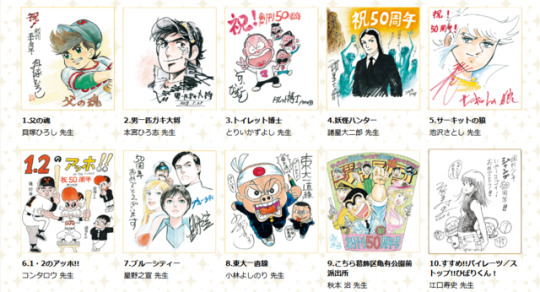


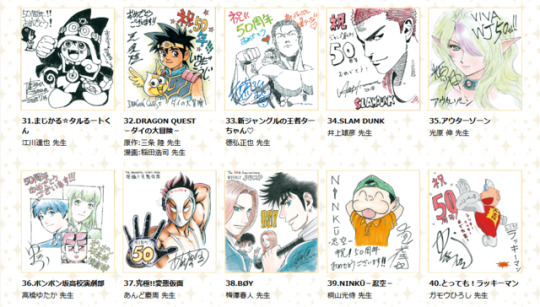
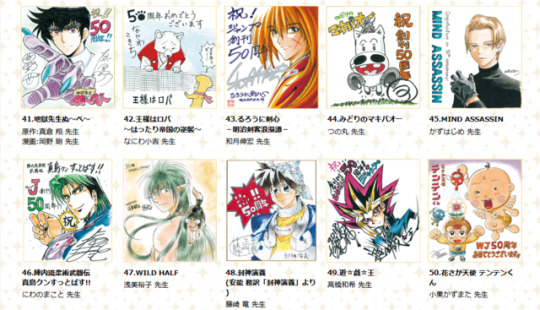
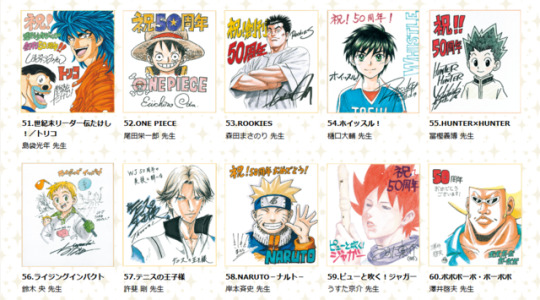
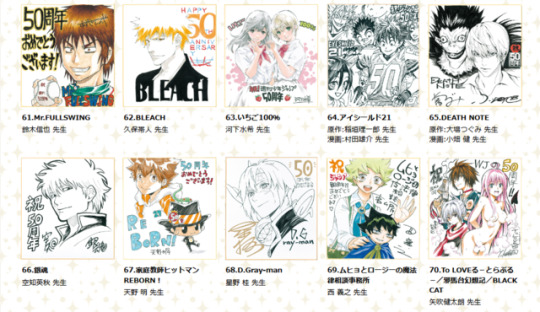

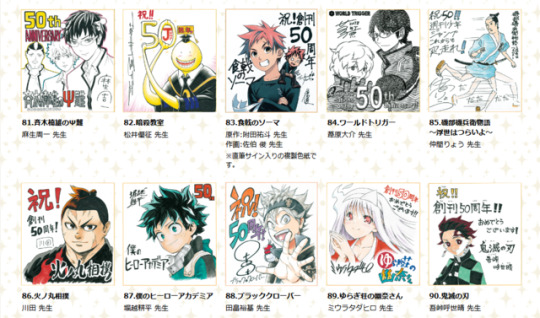

Weekly Shonen Jump 50th anniversary Shikishi
Hiroshi Kaizuka (Chichi no Tamashii)
Hiroshi Motomiya (Otoko Ippiki Gaki Daishou)
Kazuyoshi Torii (Toilet Hakase)
Daijiro Morohoshi (Yokai Hunter)
Satoshi Ikezawa (Circuit no Okami)
Kontaro (1•2 no Ahho!!)
Yukinobu Hoshino (Blue City)
Yoshinori Kobayashi (Todai Icchokusen)
Osamu Akimoto (KochiKame)
Hisashi Eguchi (Susume!! Pirates/Stop!! Hibari-kun!)
Buichi Terasawa (Space Adventure Cobra)
Yudetamago (Kinnikuman)
Yoichi Takahashi (Captain Tsubasa)
Tsukasa Hojo (Cat's♥Eye)
Shinji Hiramatsu (Black Angels)
Motoei Shinzawa (High School! Kimengumi)
Ryuji Tsugihara (Yoroshiku Mechadoc)
Masakazu Katsura (Wing-Man/Video Girl Ai/I"s)
Buronson and Tetsuo Hara (Fist of the North Star)
Yoshihiro Takahashi (Ginga -Nagareboshi Gin-)
Akira Toriyama (Dragon Ball)
Koichi Endo (Tsuide ni Tonchinkan)
Akira Miyashita (Sakigake!! Otokojuku)
Masami Kurumada (Saint Seiya)
Kouji Koseki (Kenritsu Umisora Koukou Yakyuu Buin Yamashita Tarou-kun)
Hirohiko Araki (JoJo's Bizarre Adventure)
Tadashi Sato (The Burning Wild Man)
Kouji Maki (God Sider)
Kazushi Hagiwara (Bastard!!)
Shinji Imaizumi (Kami-sama wa Southpaw)
Tatsuya Egawa (Magical Taluluto)
Riku Sanjo and Koji Inada (Dragon Quest: Dai no Daibouken)
Masaya Tokuhiro (Jungle King Tar-chan)
Takehiko Inoue (Slam Dunk)
Shin Mitsuhara (Outer Zone)
Yutaka Takahashi (Bonbonzaka High Drama Club)
Keishuu Ando (Kyuukyoku!! Hentai Kamen)
Haruto Umezawa (Hareluya II Bøy)
Kouji Kiriyama (Ninku)
Hiroshi Gamo (Tottemo! Luckyman)
Shou Makura and Takeshi Okano (Hell Teacher Nube)
Kokichi Naniwa (Ousama wa Roba ~Hattari Teikoku no Gyakushuu~)
Nobuhiro Watsuki (Rurouni Kenshin)
Tsunomaru (Midori no Makibao)
Hajime Kazu (Mind Assassin)
Makoto Niwano (Jinnai Ryuujuujutsu Butouden Majima-kun Suttobasu!)
Yuko Asami (Wild Half)
Ryu Fujisaki (Hoshin Engi)
Kazuki Takahashi (Yu-Gi-Oh!)
Kazumata Oguri (Hanasaka Tenshi Tenten-kun)
Mitsutoshi Shimabukuro (Seikimatsu Leader-den Takeshi!/Toriko)
Eiichiro Oda (One Piece)
Masanori Morita (Rookies)
Daisuke Higuchi (Whistle!)
Yoshihiro Togashi (Hunter x Hunter)
Nakaba Suzuki (Rising Impact)
Takeshi Konomi (The Prince of Tennis)
Masashi Kishimoto (Naruto)
Kyosuke Usuta (Pyu to Fuku! Jaguar)
Yoshio Sawai (Bobobo-bo Bo-bobo)
Shinya Suzuki (Mr. Fullswing)
Tite Kubo (Bleach)
Mizuki Kawashita (Strawberry 100%)
Riichiro Inagaki and Yusuke Murata (Eyeshield 21)
Tsugumi Ohba and Takeshi Obata (Death Note)
Hideaki Sorachi (Gintama)
Akira Amano (Reborn!)
Katsura Hoshino (D.Gray-man)
Yoshiyuki Nishi (Muhyo & Roji's Bureau of Supernatural Investigation)
Kentaro Yabuki (To Love-Ru/Yamato Gensouki/Black Cat)
Saki Hasemi (To Love-Ru)
Yasuhiro Kano (Mx0)
Kenta Shinohara (Sket Dance)
Hiroshi Shiibashi (Nura: Rise of the Yokai Clan)
Kouji Ooishi (Inumarudashi)
Tadatoshi Fujimaki (Kuroko's Basketball)
Ryuuhei Tamura (Beelzebub)
Nisio Isin and Akira Akatsuki (Medaka Box)
Naoshi Komi (Nisekoi)
Haruichi Furudate (Haikyu!!)
Shuuichi Asou (The Disastrous Life of Saiki K.)
Yuusei Matsui (Assassination Classroom)
Yuto Tsukuda and Shun Saeki (Food Wars!: Shokugeki no Soma)
Daisuke Ashihara (World Trigger)
Ryou Nakama (Isobe Isobee Monogatari: Ukiyo wa Tsurai yo)
Kawada (Hinomaru Zumo)
Kohei Horikoshi (My Hero Academia)
Yuki Tabata (Black Clover)
Tadahiro Miura (Yuuna and the Haunted Hot Springs)
Koyoharu Gotouge (Demon Slayer: Kimetsu no Yaiba)
Mikio Ikemoto and Ukyo Kodachi (Boruto: Naruto Next Generations)
Kaiu Shirai and Posuka Demizu (The Promised Neverland)
Taishi Tsutsui (We Never Learn)
Riichiro Inagaki and Boichi (Dr.Stone)
Tatsuya Matsuki and Shiro Usazaki (Act-Age)
Gege Akutami (Jujutsu Kaisen)
Haruto Ikezawa (Noah's Notes)
Masayoshi Satosho (Momiji no Kisetsu)
Kazusa Inaoka (Kimi Wo Shinryakuseyo)
Keiji Amatsuki (Seiji Tanaka)
Takahide Totsuno (Alice & Taiyou)
#One Piece#Naruto#My Hero Academia#Hunter x Hunter#Dragon Ball#JoJo's Bizarre Adventure#Fist of the North Star#Slam Dunk#Rurouni Kenshin#Bleach#The Promised Neverland#Death Note#Haikyu!!#Shokugeki no Soma#Gintama#Captain Tsubasa#Saint Seiya#Black Clover#Bastard!!#Eyeshield 21#To Love Ru#Reborn!#Yu Gi Oh!#Kinnikuman#KochiKame#Kuroko's Basketball#D.Gray Man#World Trigger#Weekly Shonen Jump#manga
428 notes
·
View notes
Photo



28 July 2018
The 5th and 6th performances were done! To everyone who came to watch, Thank you very much!
With Momo-sama, Senka and Banka (x, x, x)
#kosaka ryoutarou#translation#source: twitter#stage: brave10#Tanaka Toshihiko#tanoue marina#takahashi saki#brave10#Queued post#shinohara ryu#hayama subaru#matsuda kazuki#juri
6 notes
·
View notes
Text
HiGH&LOW THE MOVIE 3 FINAL MISSION (JM, 2017) (Sub. Esp)

DESCARGAR O VER ONLINE AQUÍ
Título: HIGH&LOW The Movie 3 Final Mission País: Japón Género: Acción Duración: 118 min. Fecha de estreno: 11 de noviembre, 2017 Dirección: Kubo Shigeaki, Nakakuki Tsuyoshi Guion: Hiranuma Norihisa, Watanabe Kei, Kamijo Daisuke Producción: Ueno Hiroyuki, Fujimura Naoto, Nakabayashi Chikako SINOPSIS A fin de ocultar la pasada corrupción del gobierno, el grupo Kuryu sigue un plan para destruir uan calle y construir un casino. Para detener al grupo Kuryu, los miembros de SWORD comienzan a moverse. CAST ASOCIACIÓN SANNOH Iwata Takanori como Cobra Suzuki Nobuyuki como Yamato Machida Keita como Noboru Yamashita Kenjiro como Dan Sato Kanta como Tetsu Sato Taiki como Chiharu Yagi Masayasu como Ijuin Kabuto Iwaya Shogo como Ken Yamamoto Shogo como Hikaru WHITE RASCALS Keiji como Rocky Endo Yuya como Koo Inaba Yu como Kizzy Yanagi Shuntaro como Kaito Nishimura Ikki como Heidi Hirose Tomoki como Marco Nisikawa Shunsuke como Lassie Matsuda Ryo como Cosette Kyan Yutaka como Bito Darvish Kenji como Shimura INSTITUTO OYA Yamada Yuki como Murayama Yoshiki Suzuki Takayuki como Furuya Hideto Ichinose Wataru como Seki Kotaro Aoki Ken como Nakakuki Kiyohara Sho como Nakabayashi Jinnai Syo como Nakazono RUDE BOYS Kubota Masataka como Smoky Sano Reo como Takeshi Zen como P Sano Gaku como Yu Fujii Karen como Lala DARUMA IKKA Hayashi Kento como Hyuga Norihisa Abe Ryohei como Sakyo Ozawa Yuta como Kato Shu Mizuno Masaru como Futa Tanaka Shunsuke como Raita Moriya Koji como Agyo Izawa Yuki como Ungyo DOUBT Nakamura Aoi como Hayashi Ranmaru Akiyama Shintaro como Takano Takeda Kohei como Hirai MIGHTY WARRIORS Elly como Ice Oya Kana como Sarah Nogae Shuhei como Pearl Shirahama Alan como Bernie Anarchy como 9 Likiya como Diddy Sukezane Kiki como Dixie PRISON GANG Naoto como Jesse Sekiguchi Mandy como Pho Iwanaga Joey como Brown Nakatani Taro como Mocai Jay como Nakamon Takeru como Miou Kido Yasuhiro como Akune (EX)MUGEN Akira como Kohaku Aoyagi Sho como Tsukumo HERMANOS AMAMIYA Takahiro como Amamiya Masaki Tosaka Hiroomi como Amamiya Hiroto GRUPO KURYU Tsugawa Masahiko como Kuze Ryushin Iwaki Koichi como Kurosaki Kimitatsu Kishitani Goro como Zenshin Yoshitatsu Kato Masaya como Katsunari Ryuichiro Sasano Takashi como Ueno Ryuhei Takashima Masahiro como Minamoto Ryukai Kinoshita Youka como Fujimori Tatsuo Nakamura Tatsuya como Iemura Tatsumi Saotome Taichi como Ryu Tatsuhito Kobayashi Naoki como Kuki Genji Kenchi como Nikaido Onozuka Hayato como Kirinji Takeda Kozo como Yoshida Kagetora Kuroishi Takahiro como Udaka Shinichi Yuki Jutta como Oba Kunimitsu Shogen como Okido Ken Shiroishi Tomoya como Eto Araki Hideyuki como Fukuda Watanabe Kohei como Yagi ICHIGO-MILK Kaede como Shiba Sato Harumi como Oshiage Yamaguchi Nonoka como Nonoriki Kido Airi como Ichikawa OTROS Fujii Shuka como Naomi Bando Nozomi como Ijuin Nika Nakai Noemie como Furuno Suzuki Rio como Eri Horibe Keisuke como Natano Eichi Hasegawa Hatsunori como Shinohara Toyohara Kosuke como Saigo Ikeue Kohei como Kikuchi
TRÁILER: https://www.youtube.com/watch?v=Jq7mAAjn8nw
#high and low#high&low#high & low#high&low the movie 3 final mission#exile tribe#jmovie#proyectos terminados#sub. español
8 notes
·
View notes